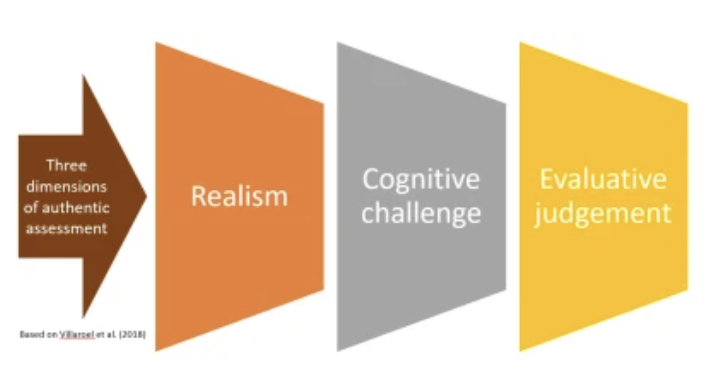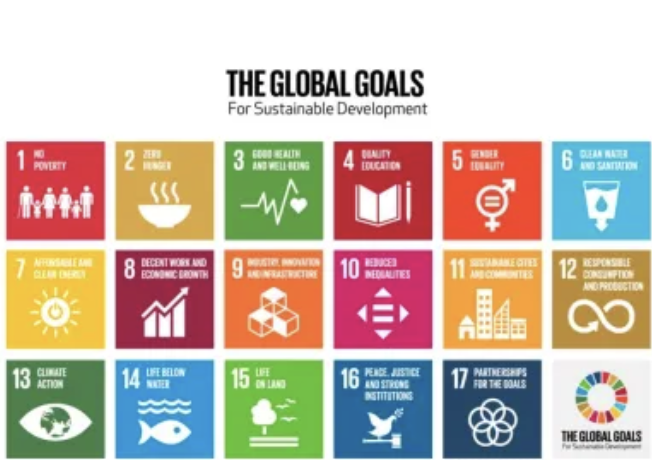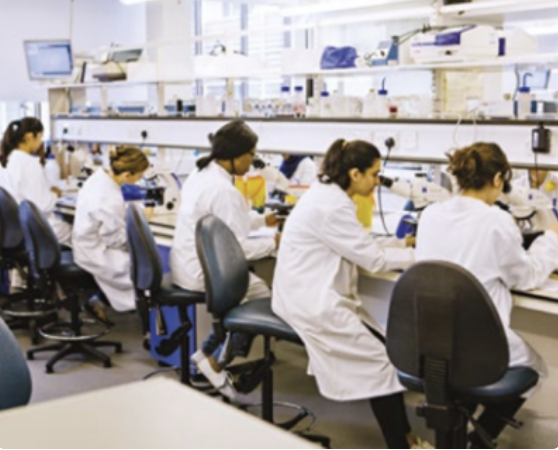By Tony Burke, Former Director of Curriculum Development
24/08/2023
The approach to assessment design outlined elsewhere on these pages lends itself very well to the adoption of authentic assessment. The University of Westminster is committed to offering authentic teaching, learning and assessment modes. Furthermore, our Assessment and Feedback Policy states unequivocally that all courses will incorporate authentic assessment approaches.
Understanding authentic assessment

Authentic assessment is widely perceived to refer to assessment tasks that require students to use the same sorts of skills that they would need in professional life. For example Gulikers et al, 2004 offer the following definition:
“….an assessment requiring students to use the same competencies, or combinations of knowledge, skills, and attitudes, that they need to apply in the criterion situation in professional life”.
However, framing authentic assessment purely in terms of training for the workplace tends to imply a somewhat utilitarian view of higher education. A more progressive way of framing authentic assessment is presented by Villaroel et al (2018). They suggest that there are three dimensions to authentic assessment:

- Realism refers to the task being contextualised in real life. Whilst this may be something that ties the task to a professional scenario, it could also be simply a real-world context for the problem that the task seeks to address.
- Cognitive challenge refers to the task requiring students to use higher order cognitive skills to build their knowledge.
- Evaluative judgement refers to the capability of students to judge their own performance and regulate their own learning. Students therefore require support through effective assessment criteria, through opportunities for formative feedback and through arrangements that promote collaboration, peer assessment and self-assessment.
Another perspective is offered by Jan McArthur of Lancaster University. Writing for the higher education policy website, WONKHE, she suggests that if assessment is to count as authentic, it must mean something to students:
“Genuine authentic assessment, therefore, also comes back to the student as a whole person. It is about the authenticity of the student as a person, not simply a particular task. Again, this enables us to have the dual flourishing of individual and social wellbeing. The problems facing society, including the economic, will require creative and flexible minds able to engage with complex problems and offer inclusive solutions.”
This focus on relevance to the student aligns well with Westminster’s strategic aim of delivering a high-quality education that offers authentic learning, and a personalised and transformative education. Thus, our assessment design should be meaningful to students’ aspirations but contextualised in real life. That will often mean that assessments will be relevant to future employment, but it could equally refer to relevance in terms of the discipline or indeed the wider needs of society.
Benefits of authentic assessment

For students:
- Facilitates deeper learning
- Helps students to become autonomous learners
- Motivates and engages students
- Develops employability skills
For staff:
- More enjoyable to work with students in supporting their engagement with the task
- More rewarding to assess the outputs of the assessment
Designing authentic assessment tasks

The process for designing authentic assessment is fundamentally no different to the general assessment design process outlined elsewhere. The starting point has to be the learning outcomes for the module. Assuming the learning outcomes have been carefully crafted, the design of the assessment tasks should be relatively straightforward. The learning outcomes should clearly indicate what we are expecting students to be able to do at the end of the module.
If we have a clear vision of what we are expecting students to be able to do, then we should be able to identify the type of tasks that will provide opportunities to demonstrate that they can do it. In this way, the assessment tasks are directly aligned with the learning outcomes.
Identify a context

A key requirement for an authentic assessment task is that it is contextualised in real life. Having established the type of assessment task that will provide opportunities for students to demonstrate achievement of the learning outcomes, we next need to identify a context.
For disciplines that are directly aligned to an area of professional practice the context will typically be provided by a professional scenario. This could include, for example, a client brief, a project, an instruction from a manager, or any type of situation that might be experienced in the professional sphere.
If your field does not relate directly to an area of professional practice, then you could consider a problem located within the conventions of the discipline – perhaps requiring students to work in specific ways associated with that discipline.

There is also nothing to stop you contextualising the task against any real-world problem or challenge, or indeed a wider problem that may be facing society. For example, the UN Sustainable Development Goals could be helpful in providing a context.
Lastly, the context could be provided by a personal challenge for students – perhaps requiring students to reflect or to develop specific skills.
The University’s Graduate Attributes can be useful in providing a series of prompts to encourage you to think more broadly beyond the domain of the subject itself.
Make it challenging

Whatever context the assessment is to be located within, if the assessment is to be authentic then we should ideally be placing students in a situation that requires them to make decisions.
Authentic assessment should involve cognitive challenge. Deep learning requires deep engagement with the task. Students should be solving problems, they might be analysing data, evaluating evidence, making judgements or creating something new. For learning to be transformative, students need to be taken outside their comfort zone. They need to make decisions. Of course, we will provide the support that students need, so they won’t just be left to flounder, but it is important for students to be stretched. Indeed, if it is possible for students to gain good marks simply by reproducing information, then the likelihood is that the task is not authentic.
Consider how students might ‘own’ the assessment
When students have some personal investment in the assessment task they are more likely to engage enthusiastically with it. This can be achieved by allowing students a degree of choice in the precise nature of the assessment task. Perhaps the object upon which the task is based may be left to the student, or maybe students can choose the medium by which they present their assessment.
If we have built the module around the assessment it tends to be easier to do this, because we have the opportunity to work with students week-by-week specifically on their engagement with the assessment. We could go even further and actually develop the assessment criteria with the students – so that they have the opportunity to contribute to the criteria that will be used to evaluate their work. This promotes a dialogue about the expectations of the assessment and it helps students to develop their capability in evaluating their own work and that of other students. Ideally, we should build in opportunities for students to reflect on their work and on the experience of doing it. This is enhanced by providing formative feedback as they progress through the task, and helping them to understand what they need to do with that feedback. It can be hugely beneficial to encourage students to self-assess their own work against the assessment criteria, and indeed to work with each other and support each other by peer assessing each other’s work. This can really promote students’ abilities as autonomous learners.
Consider how students might collaborate with one another

In the real world many challenges are tackled by groups of people working effectively together. Professional environments require people to collaborate. To enhance authenticity, we might consider how students can collaborate with each other in tackling the assessment task. This might mean working together on a group assessment, but even if we want to avoid groups assessments, there may be ways in which students can work together on research and share the outputs, even though the final submission may be an individual submission.
Consider how external stakeholders might contribute

Authenticity can be significantly enhanced by the involvement of external stakeholders. External stakeholders include employers, large corporations, public sector bodies, charities, cultural organisations, community groups or many others. They might get involved in setting a ‘live’ brief, providing an authentic scenario, feeding into the guidance provided to students, hosting a site visit, or even providing formative feedback to students at an appropriate point in the programme. Students really value the ‘real-world’ input provided external stakeholders .
Summary

By adopting an authentic assessment approach and placing assessment at the heart of our modules, we effectively make assessment the vehicle that facilitates the learning journey. It is through engagement with the assessment that students actually reach the learning outcomes.
References
Gulikers, J.T., Bastiaens, T.J. and Kirschner, P.A. (2004). A five-dimensional framework for authentic assessment. Educational technology research and development, 52 (3), 67.
McArthur, J. (2021); For assessment to count as authentic it must mean something to students; WONKHE 3/03/21 [Online] Available at https://wonkhe.com/blogs/for-assessment-to-count-as-authentic-it-must-mean-something-to-students/
Villarroel, V.; Bloxham, S.; Bruna, C. and Herrera-Seda, C. (2018). Authentic assessment: creating a blueprint for course design. Assessment & Evaluation in Higher Education, 43 (5), 840–854.
Links to external resources
Listed below are various resources from the higher education sector that provide additional guidance and examples for authentic assessment:
- A resource created by Professors Sally Brown and Kay Sambell that presents a case for authentic assessment as an alternative to traditional forms of assessment. Offers a helpful table of assessment outputs that provides a wide range of examples of authentic assessment approaches.
Binary Choices? Authentic Assessment vs Traditional
- A blog post by Lydia Arnold that challenges the simplistic binary choice between authentic and traditional assessment approaches.
Rethinking authentic assessment: work, well-being, and society
- Journal article by Jan McArthur (2023) in Higher Education that seeks to offer a deeper understanding of authentic assessment
- Journal article by Sokhanvar et al. (2021) in Studies in Educational Evaluation that presents a systematic review of the literature investigating the advantages of authentic assessment. The review found that authentic assessment does provide opportunities to improve student engagement and to develop students’ employability skills.
Authentic Assessment Top ‘Reflective’ Trumps!
- A resource created by Lydia Arnold that offers a set of cards that can be downloaded and used in a creative way to provide ideas and inspiration for authentic assessment tasks.
Assessing Authentically: Assessment as Learning Toolkit
- Toolkit produced by the University of New South Wales in Australia. Includes very helpful guidance on designing authentic assessments.
Authentic Assessment in Irish Higher Education
- A guide produced by the Irish National Forum for the Enhancement of Teaching and Learning in Higher Education. Includes examples of authentic assessment and a helpful model showing a continuum of authenticity.
Latest posts by ferzanr2 (see all)
- Sustainability Autumn Newsletter - December 6, 2024
- Module Leader Continuous Improvement Report - December 4, 2024
- Celebrating Multilingualism at Westminster - November 28, 2024








Leave A Comment